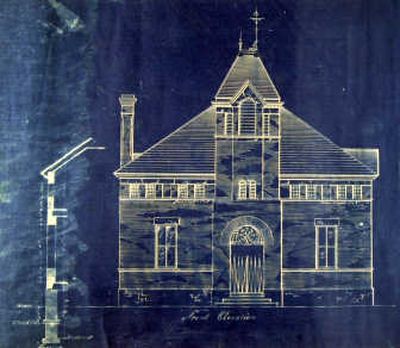Pledge offered to refurbish Rathdrum jail building

RATHDRUM – An unidentified donor recently pledged up to $650,000 for restoration of Rathdrum’s 1890 Kootenai County jail building. The brick building, which is listed on the National Register of Historic Places, has long been of interest to the Rathdrum/Westwood Historical Society, whose members were surprised to hear of the offer to restore the building they have been working on since 2000.
The two-story structure was designed by the architectural firm of Galbraith and Fuller of Missoula, and was constructed by the O’Sullivan Brothers of Coeur d’Alene at a cost of $2,500 during the 27 years Rathdrum served as the center of Kootenai County government (1881-1908). Built in the new-Romanesque design, (late Victorian), the formidable building featured thick walls, steel bars and cut granite sills and lintels. No one seems to remember when the once-grand entry featuring a handsome brick belfry disappeared.
The building served as the county Sheriff’s Office and jail until 1908, when Coeur d’Alene was named the county seat. On March 17, 1910, the jailhouse was sold to the Village of Rathdrum for $225.
The city used the building for more than 90 years, first as a library and later as a maintenance shop for the Public Works Department. The city discontinued use of the badly neglected building in 1999, and historical society members became interested in the possibility of using it as a museum. Others have long considered the possibility of building a heritage park on the city-owned land near the jail.
Grants from the Idaho Heritage Trust, the Gem Community and the city of Rathdrum helped reroof the building in 2000. Since that time, interior renovation work has continued through additional small grants from the city and funds raised by the historical society through the Fall Heritage Festival and other events.
In 2006, the city transferred ownership of the building to the Rathdrum/Westwood Historical Society, a nonprofit organization whose members learned of the restoration offer at a recent meeting. They were told the donor expressed hopes that matching grants could be found, believing final restoration costs could run to more than $1 million. Local architect Paul Matthews has been asked to prepare a bid for the extensive project, which will be guided by National Trust for Historic Preservation restoration guidelines and design review.
Idaho historic preservation officials for the National Trust for Historic Preservation toured the jail in 2005 and expressed their appreciation for the importance of the building. They were surprised to find original blueprints on display, noting the blueprints would make a complete restoration of the grand front entrance possible.
The 4,000-square-foot building is divided into three areas; a formal front entry hall, a two-story front section and a rear section. The front section originally contained offices for the sheriff and jailer on the first floor, along with a waiting room, kitchen, visitor’s gallery and a small washroom. The second floor included two rooms and a bathroom, as well as five small cells along the front designed as holding cells and confinement for mentally unstable prisoners.
The two-story rear section was known as the cell, or cage room. Male prisoners were kept in eight double-tiered, free-standing, steel cells in the large space, with little light coming in from tall, narrow, barred windows. The upper cells were reached from a narrow catwalk around the exterior of the block. Evidence of a small brick room, once used as a women’s ward, remains on the exterior of the north wall. The 1896 addition was removed during the 1970s.
According to Rathdrum/Westwood Historical Society President Ellen Larsen, the donor is a Rathdrum resident who would like to give something back to the community and chose the historic jail as a worthy project. She said the historic society is thrilled with the offer and that the next step will be for the group to begin looking for preservation grants.